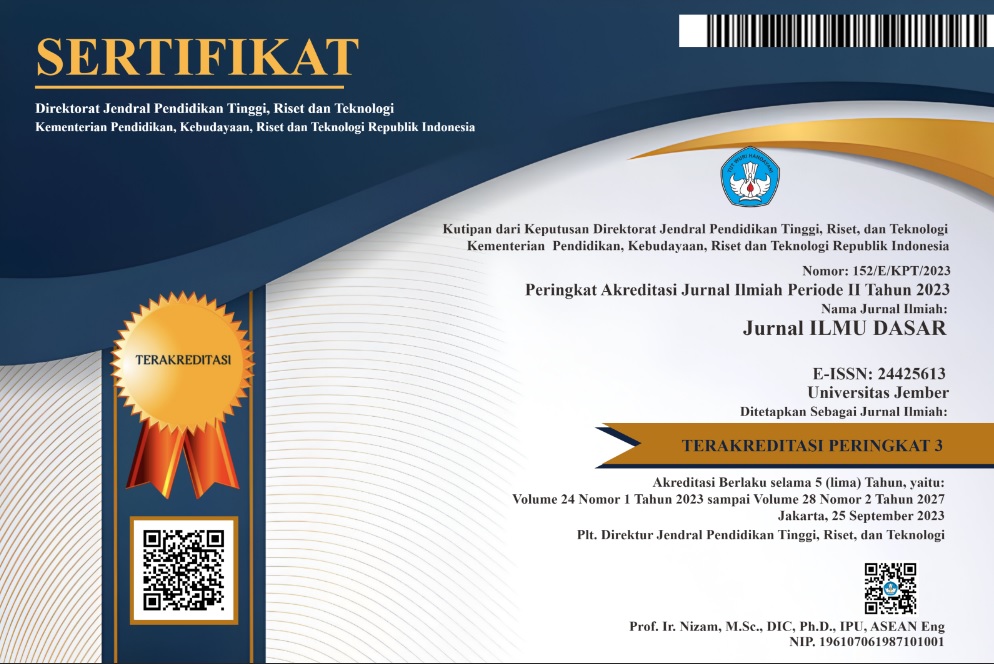Construction and expression of Wee1 recombinant protein in Escherichia coli strain BL21 (DE3)
DOI:
https://doi.org/10.19184/jid.v24i2.28232Keywords:
Weel, construction, synthesis, recombinant protein, Escherichia coliAbstract
Wee1 is a gene encoding for protein kinase that is located in the nucleus and it plays an essential role in determining the timing of mitosis. Overexpression of Wee1 in rice is resulting in increased plant size. However, the increasing plant size due to the increase of Wee1 protein expression is not elucidated. Immunodiagnostic using specific antibodies against Wee1 protein should be conducted to determine the role of the protein on cell division. This experiment was directed to construct Wee1 in an expression vector for synthesis of recombinant Wee1 protein using three strategies of construction. The three strategies were construction of full length (FL), deletion of putative binding site (BS), and deletion of N-terminal domain (ΔN) of Wee1. Restriction analysis with BamH1/Sal1 of FL-Wee1, BS-Wee1, and ΔN-Wee1 construct resulted in the different DNA fragments with molecular size at 1239, 1176, and 960bp, respectively. This result indicated that the Wee1 fragments have been successfully inserted in the expression plasmid which was further confirmed using DNA sequencing. Colony PCR analysis showed that Escherichia coli strain BL21 (DE3) has been transformed with the constructs. The protein analysis using SDS-PAGE revealed that the recombinant protein of Wee1 synthesized in the E.coli containing ΔN-Wee1 construct, but not in FL-Wee1 and BS-Wee1 constructs. The ΔN-Wee1 protein was synthesized in an insoluble fraction with a molecular size of 38.8 kDa which is the same as the size estimated using the software ExPASy. Interestingly, the level of synthesized ΔN-Wee1 protein was not induced by IPTG concentration. Collectively, the results indicated that the DNA construct of ΔN-Wee1 is suitable for recombinant protein production.
Downloads
References
Apriasti R, Widyaningrum S, Hidayati WN, Sawitri WD, Darsono N, Hase T & Sugiharto B. 2018. Full Sequence of The Coat Protein Gene is Required for The Induction of Pathogen-Derived Resistance Against Sugarcane Mosaic Virus in Transgenic Sugarcane. Molecular Biology Reports. 45(6): 2749-2758.
Emantoko S. 2001. Antibodi Rekombinan: Perkembangan Terbaru dalam Teknologi Antibodi. Unitas. 9(2): 29-43.
Ermawati N & Wibisono Y. 2017. Early Isolation of Cell Cycle-Associated Protein Kinase (Oswee) Gene in Rice (Oryza Sativa L.). Biotechnol. 14(1): 71-76.
Gonzalez N, Gévaudant F, Hernould M, Chevalier C & Mouras A. 2007. The Cell Cycle-Associated Protein Kinase Wee1 Regulates Cell Size in Relation to Endoreduplication in Developing Tomato Fruit: Wee1 and Cell Size Control in Tomato. The Plant Journal. 51(4): 642-655.
Gopal GJ & Kumar A. 2013. Strategies for the Production of Recombinant Protein in Escherichia coli. The Protein Journal. 32(6): 419-425.
Green M & Sambrook J. 2012. Molecular cloning: A laboratory manual. 4th Edition, Vol II. Cold Spring Harbor Laboratory Press.
Ishii M, Nakakido M, Caaveiro JMM, Kuroda D, Okumura CJ, Maruyama T, Entzminger K & Tsumoto K. 2021. Structural Basis for Antigen Recognition by Methylated Lysine–Specific Antibodies. Journal of Biological Chemistry. 296: 100176.
Ko C, Ma J, Bartnik R, Haney MH & Kang M. 2018. Ethical Leadership: An Integrative Review and Future Research Agenda. Ethics & Behavior. 28(2): 104-132.
Lucena R, Alcaide-Gavilán M, Anastasia SD & Kellogg DR. 2017. Wee1 and Cdc25 are Controlled by Conserved PP2A-dependent Mechanisms in Fission Yeast. Cell Cycle. 16(5): 428-435.
Nurse P & Thuriaux P. 1980. Regulatory Gene Controlling Mitosis In The Fission Yeast Schizoasaccharomyces pombe. Genetics. 96(3): 627-637.
Prasetyo FHH, Sugiharto B & Ermawati N. 2018. Cloning, Transformation and Expression of Cell Cycle-Associated Protein Kinase OsWee1 in Indica Rice (Oryza sativa L.). Journal of Genetic Engineering and Biotechnology. 16(2): 573-579.
Qiu C, Yi Y, Lucena R, Wu M, Sun J, Wang X, Jin Q & Wang Y. 2017. SCFPof3 and SCFPof1 Regulate Wee1 Degradation and Mitotic Entry in Fission Yeast. Journal of Cell Science. jcs.202895.
Rosano GL & Ceccarelli EA. 2014. Recombinant protein expression in Escherichia coli: Advances and challenges. Frontiers in Microbiology. 5.
Sawitri WD, Narita H, Ishizaka-Ikeda E, Sugiharto B, Hase T & Nakagawa A. 2016. Purification and Characterization of Recombinant Sugarcane Sucrose Phosphate Synthase Expressed in E. coli and insect Sf9 cells: An Importance of The N-terminal Domain for an Allosteric Regulatory Property. Journal of Biochemistry. 159(6): 599-607.
Schumann W & Ferreira LCS. 2004. Production of Recombinant Proteins in Escherichia coli. Genetics and Molecular Biology. 27(3): 442-453.
Septian A, Neliana IR, Kusumawardani B & Sugiharto B. 2021. Pengujian Potensi Alergenitas Coat Protein Sugarcane Mosaik Virus Pada Tanaman Tebu transgenik. Jurnal Bioteknologi & Biosains Indonesia, 8(2): 2008-2019.
Siciliano I, Lentz Grønlund A, Å evÄÃková H, Spadafora ND, Rafiei G, Francis D, Herbert RJ, Bitonti MB, Rogers HJ & Lipavská H. 2019. Expression of Arabidopsis Wee1 in Tobacco Induces Unexpected Morphological and Developmental Changes. Scientific Reports. 9(1): 8695.
Sumirasih T. 2018. Kajian DNA Rekombinan pada Vaksin DNA dan Vaksin Subunit Protein. Pharma Medika. 10(2): 108-128.
Sun Y, Dilkes BP, Zhang C, Dante RA, Carneiro NP, Lowe KS, Jung R, Gordon-Kamm WJ & Larkins BA. 1999. Characterization of maize ( Zea mays L.) Wee1 and Its Activity in Developing Endosperm. Proceedings of the National Academy of Sciences. 96(7): 4180-4185.








